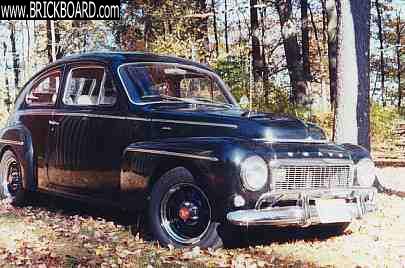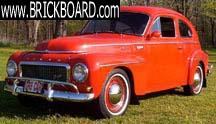
|
|
What is the purpose of the coolant tube that runs through the Weber DGV 32/36 manifold? Is to heat the mixture, cool the manifold to compensate for heat rising from the exhaust manifold, or has it something to do with a Weber-idiosyncratic operating principle? Here's the deal: I am thinking of using one of these manifolds, after some adaptation, with a Solex Pict 30 carb on my B9 (B18:2) powered generator project, which you may recall my Nov.18 post, and I'm wondering if I could get away with not routing coolant through the manifold. I have a spare set of SUs I could use, but I'd just as soon keep them for real Volvo application.
Bob S.
|
|
-
|
|
|
Not that I'm calling into question the wisdom of the other posters, but...
The information I have is that the water passage actually does TWO things.
1] As everybody else says, the circulating coolant will WARM the mixture when the weather is cold.
2] but also, the coolant will COOL the mixture when things start being warm, what with the carb being right near the exhaust manifold. That is...
The overall purpose of the coolant flow is to STABILIZE the air/fuel mixture at around 190f.
But for a stationary application, I would do absolutely nothing until problems arise. Then, perhaps, I'd think about routing some hose.
|
|
-

|
|
I used the manifold and carb. you describe on my 544 (B18) for a couple of years. I'm not sure of the purpose of the connections, but they were not used the entire time and the engine ran very good.
|
|
-
|
|
|
It's to warm the mixture in cold weather.
--
George Downs Bartlesville, Heart of the USA!
|
|
-
|
|
|
Hi Bob,
It's to warm the manifold and help vaporize gas that's fallen out of suspension -- there's a tendency for gas to pool directly under the carburetor, which is why downdraft Webers have their own burbly sound at idle.
You can get away with not connecting it. Many don't.
Merry Xmas!
|
|
-

|
|
Phil,
OK, good, then I won't. There's only about 1/2" space between it and the exhaust manifold, so, that box under the carb should get plenty hot. If not, I can wedge a piece of aluminum or copper between the two to increase heat transfer,but I don't think that'll be necessary.
And a happy NY too,
BobS
|
|
-

|
|
I'd connect it. It makes tuning more stable & it boosts idle & part throttle fuel economy. It will cost some full throttle power, but, if you restrict the amount of hot water moving through it, you can minimize the HP loss. I don't know how big the water hoses are, but I'd try 1/4" hose. You can push a short length of 1/4" or 5/16" fuel hose up 5/8" heater hose if that's what the manifold uses.
|
|
-
posted by
someone claiming to be dxhall
on
Mon Dec 25 13:59 CST 2006 [ RELATED]
|
|
In good weather, the DGV will work fine without a heated manifold. In cold, wet weather, though, it will ice up, the motor will die, and you will get wet feet walking home. If you live where it's cold and snowy, do yourself a favor and connect the water hoses.
|
|
-
|
|
|
Huh. I always thought that the coolant pipe was just for the DGAV- the thermostatically controlled automatic choke of the DGV series. I've done a manual choke conversion on one and it ran fine disconnected, but maybe that's becasue I'm in northern California...
--
'66 122s, '70 142s, '74 142e... Blue is beautiful.
|
|
-

|
|
I believe the Solex Pict 30s (air-cooled VW) have an electrical choke. So, once wired up, that should do the trick. If I notice icing, I'll rig heat transfer from the exhaust manifold. Should that fail, I have a spare heater supply tube I can modify to attach hoses for heating the manifold. Thanks for the in-put, all.
Bob S.
|
|
-
posted by
someone claiming to be dxhall
on
Tue Dec 26 16:16 CST 2006 [ RELATED]
|
|
Many of us in Denver right now wish we were in California. Anyway, the carbs can ice up because, as air goes through the venturi in the carb throat, both pressure and temperature drop. If the ambient temperature is in the middle 30s and if the air is saturated with water (like in a sleet storm), the temperature drop in the venturi will cause the air to go below 32d, which will cause the water vapor in the saturated air to condense and freeze. Waterproof shoes can be helpful, but the hoses are cheaper and less aggravating.
|
|
-

|
|
The evaporation of the gasoline into the air also adds to the temp drop.
--
'63 PV544 rat rod, '93 Classic 245 + turbo
|
|
|
|
|




